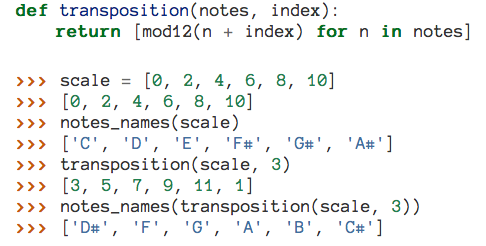I’m happy to announce that I’m launching my ebook, Music for Geeks and Nerds. It uses programming and mathematics to teach same aspects of music and it answers long-standing questions such as why Eb and D# are different, and which sequence sounds better, Pascal’s triangle or Fibonacci (place your bets). I wrote it because I have friends who are programmers, computer scientists, or engineers and they are always asking me for book recommendations to learn more about music. There are good books out there, but I always feel they present things in a prescriptive, “magical”, or worse, artsy way.
We can see music in three layers:
- natural: acoustics and psychoacoustics.
- logical: the math for things like transposition and inversion.
- social: the result of social conventions and usage over hundreds of years such as note and interval names.
I find that hackers and programmers can learn the first two layers very quickly and, as a result, they can have a better understanding of the social layer. In the book I explain musical concepts in English with a corresponding implementation in Python, using the Pyknon music library. By implementing musical concepts in a programming language we can have a more precise way to describe and understand them.
For instance, some music students have problems to transpose notes mentally. However, it becomes easy once you realize that transposition is nothing more than the sum of a note and a transposition index (in the following example we use an integer notation for notes where C = 0, C# = 1, …, B = 11):

I wrote the book using the reStructuredText markup and I used Sphinx to
generate the following formats: black & white pdf (for the printed version), color pdf,
mobi for kindle, epub, and html (for previewing). My favorite feature in Sphinx is the
literalinclude directive with the pyobject option to include the source code of
functions and methods.
My second favorite feature is the possibility of creating custom directives. For example, I created a directive to insert the source code and the result of its execution in a Python REPL, as we can see in the transposition example above. I also created custom layouts for epub, mobi, and latex, and did some bending to use XeLaTeX (to be able to use nicer fonts). I’ll write about the details of using Sphinx to write books in an upcoming blog post.
Finally, I used the services of Proofreadingpal to professionally proofread and edit the manuscript.
I’m very pleased with the result. The idea for this book has been in the back of my head for a long time and it’s a joy to finally see it materialize. If you have suggestions or questions, I’d love to hear from you.